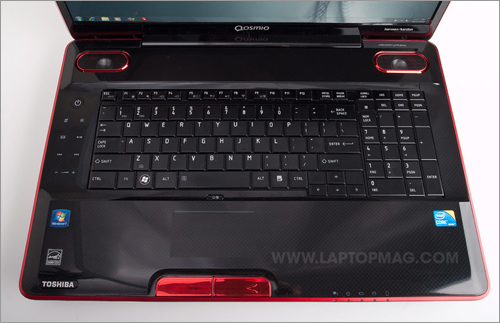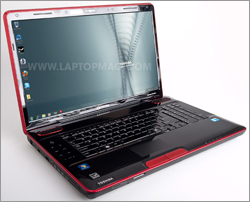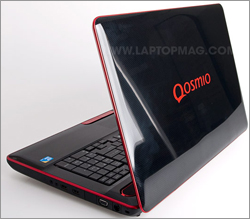Laptop Mag Verdict
A blazing-fast 18-inch desktop replacement with Intel Core i7 power and smooth Blu-ray playback.
Pros
- +
Incredible overall performance
- +
Blazing-fast SSD
- +
Bright, full HD display
- +
Loud, clear speakers
- +
Good Blu-ray playback
Cons
- -
Modest frame rates at highest resolution
- -
Slippery keyboard
Why you can trust Laptop Mag
If you're looking for a high-powered gaming notebook with all the goods, the Toshiba Qosmio X505 offers the best combination of performance and value we've seen lately. This 18-inch system delivers remarkable performance by combining a powerful Intel Core i7-720QM CPU with an Nvidia GeForce GTS 250M graphics card, 6GB of DDR3 RAM, and dual storage drives, one of whichis a high-speed 64GB SSD. The tastefully-designed rig also includes a bevvy of entertainment options, including a Blu-ray drive, a gorgeous 18.4-inch full HD (1920 x 1080) display, and a pair of Harman/Kardon stereo speakers. If you can afford the modest sub-$2,000 price and live with its 10.4-pound weight, this is the multimedia machine to beat.
Design
At a size of 17.4 x 11.6 x 1.6 inches and a weight of 10.4 pounds (11.6 pounds if you include the 1.2-pound power brick you'll need to carry), the Qosmio X505 is barely portable. But large gaming notebooks aren't intended for long trips; they're meant to maintain a smaller footprint and travel more easily than a desktop. If you need a system you can take with you to a gaming party, or (if you're a college student) something you can lug home with you for holiday breaks, the X505 more than fills the bill.
Like the Toshiba Qosmio X305 we reviewed in February 2009, the X505 has a red and black color scheme. However, this time around, Toshiba has replaced the gaudy red lid and translucent red plastic accents on its older system with a piano black chassis that has a matching black lid with several tasteful red accents--including metallic red trim and mouse buttons, and red system lights, including one that illuminates the touchpad. Compared to other gaming notebooks we've seen--including the pricey Alienware M17x--this is a design that even a gamer over 30 can display with pride.
Ports
The Qosmio X505 has all the ports you'd expect out of a multimedia/gaming rig, including a 5-in-1 memory card reader, audio in/out, Ethernet, an ExpressCard/54 slot, FireWire, HDMI, a Kensington lock slot, RGB, and 4 USB 2.0 ports, one of which is a combo eSATA/USB port. The eSATA/USB port supports Toshiba's Sleep-and-Charge feature, which allows users to charge USB devices, such as MP3 players and phones, even when the system is asleep. The X505 also comes with a Bluetooth 2.1 + EDR radio for connecting wirelessly to headsets and phones.

Click to enlarge

Click to enlarge
Keyboard and Touchpad
The spacious 104-key keyboard includes a full numeric keypad, and lights up to help gamers who are playing in dim rooms. We completed the Ten Thumbs Typing Test (www.tenthumbstypingtutor.com) in our usual 80 words per minute with a 2-percent error rate. However, we wish the keys were less glossy; our fingers slipped around periodically as we typed. We also found ourselves hitting the Caps Lock key by accident when we we were trying to hit the left Shift key while touch typing.

Click to enlarge
To the left of the keyboard are a set of media control buttons for playing discs, lowering/raising volume, muting the speakers, launching Windows Media Player, and opening Toshiba's Eco utility, which lets you see how much electricity the system is using and adjust the power settings accordingly.
The touchpad has a comfortable, lightly-textured surface that made it easy for us to navigate around the desktop (or play games) with a great deal of accuracy. However, the X505 falls short when it comes to multitouch support. Using the pad, we were able to zoom in/out on images and Web pages by pinching, but we could not rotate images or scroll with multitouch gestures like we could on other recently tested notebooks, such as the Lenovo ThinkPad T400s.
Screen and Webcam

Click to enlarge
The Qosmio X505's 18.4-inch screen delivers brilliant images at an impressive full HD resolution of 1920 x 1080. In our tests, colors remained bright and vibrant at a 45 degree angle, and washed out only slightly at a full 90 degrees to the right or left.
The X505's 1.3-megapixel webcam produced sharp, clear images. Toshiba also bundles a utility that lets you fine tune the brightness and contrast of the cam. While talking on Skype in a dim room, our image was sharp and motion was smooth, but fine details of our face were harder to make out. However, when we changed the webcam's profile to Conference mode, the image quality improved dramatically.
Multimedia
You can enjoy a movie very comfortably with a room full of friends on the Qosmio X505, without attaching an external display or speakers. When watching an episode from Heroes, both on Blu-ray and on standard DVD, images were sharp and colors vibrant, though the screen was so sharp we could see every imperfection in the Blu-ray version when sitting close to the screen. Even the pores on characters' faces were visible.
When watching the final scene of Dark City, one we often use to evaluate multimedia performance because it moves rapidly from night to day, colors were true, and background noise was minimal.
Performance
The Qosmio X505's Intel Core i7-720QM, 6GB of RAM, and 64GB SSD boot drive combined to produce a best-in-class score of 5,399 on PCMark Vantage, a benchmark that measures overall system performance. The X505's score was about 120 points higher than our previous gaming champ, the $4,649 Alienware M17x (5,276), well ahead of the Gateway P-7808u FX (4,249) and MSI GT725 (4,638), and over 1,500 points higher than the category average for desktop replacement notebooks, Only the unbranded, whitebox Intel notebook we tested, which had a more powerful Core i7-920QM CPU, scored better.
When it came to video transcoding, the X505 also excelled. It took only 2 minutes and 59 seconds to transcode a 114MB MPEG-4 file to an AVI using HandBrake, which is less than half the category average (6:02), about on par with the Alienware M17x (2:55), and well ahead of the MSI GT725 and Gateway P-7808u FX (both of which clocked in at 3:36).
When using vReveal, which takes advantage of the Nvidia video card's CUDA technology to improve the transcoding process, the Qosmio X505 completed the conversion in a mere 1 minute and 29 seconds, 21 seconds faster than the Alienware M17x (1:50), which had been the previous leader. When using Oxelon Media Converter, a video editing program that's optimized for quad-core processors, our transcoding time dropped again to just 59 seconds.
The X505 has two storage drives: a speedy 64GB Toshiba SSD, which holds the operating system and frequently-used programs, and a 7,200-rpm, 320GB Hitachi hard drive for storing everything else. The SSD booted to Windows 7 Home Premium in a speedy 48 seconds, 18 seconds faster than the category average of 66 seconds.
It also set a category record in our LAPTOP Transfer Test, taking a mere 1 minute and 15 seconds to copy 4.97GB of mixed media for a blistering rate of 67.9 MBps. The 7,200-rpm hard drive was no slouch either, completing the same test in 2 minutes and 35 seconds for a rate of 32.8 MBps. Both scores were well above the category average of 22.9 MBps, and the SSD blew away competitors like the Alienware M17x (37.1 MBps), Gateway P-7808u FX (23.6 MBps), and MSI GT725 (28.0 GBps).
Graphics and Gaming
The Qosmio X505's Nvidia GeForce GTS 250M GPU returned a strong score of 8,313 on 3DMark06, which measures overall graphics performance. This score was well above the category average (6,202), but trailed those provided by some of its competitors; the MSI GT725 (9,859), Gateway P-7808u FX (10,019), and Alienware M17x (13,463) all scored higher.
When playing games, the X505 really showed its graphics processing muscle. In Far Cry 2, it managed a rate of 88 frames per second at 1024 x 768, which is well above the category average (60 fps), and a bit higher than the Gateway P-7808u FX (85 fps) and MSI GT725 (84 fps).
However, the Alienware M17x (99 fps) was way ahead of it. At its native resolution of 1920 x 1080, the X505 managed 28 fps, which is not nearly as good as the Alienware M17x (69 fps). The MSI GT725 also did better (44 fps) at its native res of 1920 x 1200.
Despite the lower frame rates, the overall gameplay experience at full HD was excellent. When playing Call of Duty: World at War at 1920 x 1080, we could see such fine details as the grain in wood while getting very playable rates of 36 fps.
Wireless
The Qosmio X505's 802.11b/g/n Realtek Wi-Fi card delivered a transfer rate of 20.4 Mbps from 15 feet, which is about on par with the 20.0 Mbps category average, and right around the rates of competitors like the Gateway P-7808u FX (20.0 Mbps), MSI GT725 (20.4 Mbps). However, the Alienware M17x (24.3 Mbps) was several megabits faster.From 50 feet, the X505 showed poor connectivity, achieving a throughput of just 8.8 Mbps; that's nearly half the category average.
Battery
Because large, heavy gaming notebooks like the X505 use a lot of power, we don't expect much in the way of battery life. After all, how often are you going to put a 10.4-pound system on your lap, or use it on an airplane? Nevertheless, we were pleasantly surprised when the Qosmio lasted exactly 3 hours on the LAPTOP Battery Test, which involves continuous Web surfing over Wi-Fi.
This endurance is about 20 minutes longer than the category average for desktop replacements (2:36), and about twice as long as the Alienware M17x (1:34). However, the Gateway P-7808u FX (3:43) did better, and the MSI GT725 (2:45) came close.
Green Testing
To get the battery charged to 80 percent, the X505 took 1 hour and 28 minutes. However, getting to 100 percent took an additional 1:01, for a total time of 2:29. During charging the system used 10519.4 watts.
You wouldn't expect an 18.4-inch gaming notebook to be the greenest notebook on the block, but the X505 is actually better than the average desktop replacement when it comes to energy efficiency. Its LAPTOP Battery Efficiency Rating, which is defined as watts to charge divided by battery life, was 58.4--slightly better than the 59.9 average, and far superior to the 125.2 turned in by the Alienware M17x.
Software and Warranty
The Qosmio X505 comes bundled with a number of useful applications. Microsoft Works 9 provides scaled-down word processing, spreadsheet, and database apps. Corel DVD MovieFactory lets you burn DVDs. InterVideo WinDVD plays Blu-ray discs, though it automatically turned off Windows 7's Aero effects whenever we used it.
In addition to these third-party apps, there are a number of bundled Toshiba utilities. Toshiba Recovery Media Creator lets you burn system rescue discs. Toshiba ConfigFree manages network connections. Toshiba Disc Creator is a standard CD/DVD burning program, while Toshiba DVD Player allows you to view standard DVD movies, though its upscale feature actually made image quality worse when we used it.
There's also a Toshiba facial recognition program, which we don't recommend using. In general, we find that facial recognition software takes a lot longer than simply typing in a password; in our tests, it took about 5 minutes to set up a facial account, which later did not recognize us, even though we were wearing the same glasses and sitting in the same position.
Toshiba's power-saving eco Utility and PC health monitor are the most interesting of its bundled utilities. The eco Utility allows you to see, in real-time, how much power the system is using, and to adjust power settings accordingly. The PC Health Monitor shows the temperature of the CPU, the fan speed, battery status, power consumption, and health of both storage drives. We wish, however, that we were able to control the fan speed manually.

Click to enlargeThe X505 comes with a standard one-year warranty on parts and labor. Toll-free phone support is available 24/7. To see how Toshiba fared in our Tech Support Showdown, click here.
Verdict
At $1,899, the Toshiba Qosmio X505 isn't exactly cheap, but it's a bargain compared to more expensive systems like the Alienware M17x and ASUS W90, especially considering that neither of those systems come standard with a fast solid state drive. While some slightly less expensive systems like the Gateway P-7808u FX and MSI GT725 provide slightly higher frame rates in some games, the Qosmio X505's outstanding overall performance, blazing fast SSD, stylish chassis, and smooth Blu-ray playback make it a more compelling system. If you're looking for a portable gaming rig that can serve as a home theater and costs under $2,000, the Qosmio X505 is the leading choice.
Toshiba Qosmio X505 Specs
| Bluetooth | Bluetooth 2.1 EDR |
| Brand | Toshiba |
| CPU | 1.6-GHz Intel Core i7-720QM |
| Card Slots | 5-1 card reader, ExpressCard/54 |
| Company Website | http://www.toshibadirect.com |
| Display Size | 18.4 |
| Graphics Card | Nvidia GeForce GTS 250M |
| Hard Drive Size | 64GB SSD and 320GB |
| Hard Drive Speed | 7,200rpm |
| Hard Drive Type | Multiple Drives |
| Native Resolution | 1920x1080 |
| Operating System | MS Windows 7 Home Premium (64-bit) |
| Optical Drive | BD-ROM/DVD |
| Optical Drive Speed | 6X |
| Ports (excluding USB) | Headphone, HDMI, eSATA, VGA, S/PDIF, Microphone, Kensington Lock |
| RAM | 6GB |
| RAM Upgradable to | 8GB |
| Size | 17.4 x 11.6 x 1.6 inches |
| USB Ports | 4 |
| Video Memory | 1GB |
| Warranty/Support | One-year limited/24/7 toll-free phone |
| Weight | 10.4 pounds |
| Wi-Fi | 802.11b/g/n |

